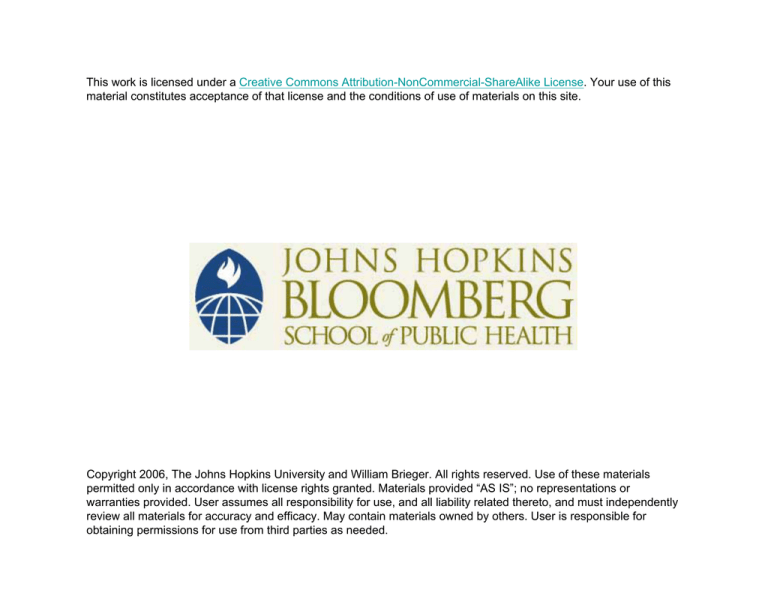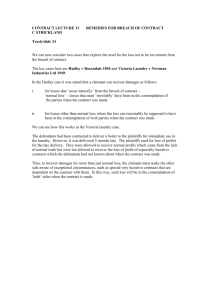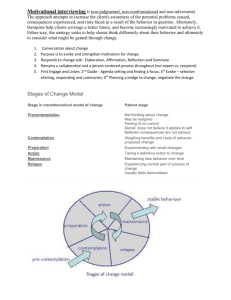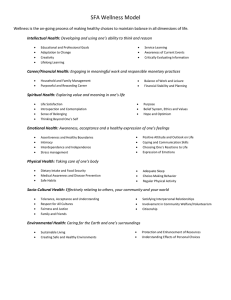
This work is licensed under a Creative Commons Attribution-NonCommercial-ShareAlike License. Your use of this
material constitutes acceptance of that license and the conditions of use of materials on this site.
Copyright 2006, The Johns Hopkins University and William Brieger. All rights reserved. Use of these materials
permitted only in accordance with license rights granted. Materials provided “AS IS”; no representations or
warranties provided. User assumes all responsibility for use, and all liability related thereto, and must independently
review all materials for accuracy and efficacy. May contain materials owned by others. User is responsible for
obtaining permissions for use from third parties as needed.
Organizational Diagnosis
William R. Brieger, MPH, CHES, DrPh
Johns Hopkins University
1
Section A
Organizations
WHO
Headquarters,
Geneva
2
Definitions of an Organization
Ù An organization is the coordination of
different activities of individual
contributors to carry out planned
transactions with the environment
Continued
3
Uganda health facility: First contact
with the formal organization
4
Definitions of an Organization
Ù An organization is an open system that
is in constant interaction with its
environment, taking in raw materials,
people, information, and energy,
converting these into products or
services, and exporting the latter back
into the environment
5
What Is an Organization?
Ù A social structure in that personnel
must interact continually during the
input-to-output process
Ù These interactions may be positive
forces that enable the organization to
function smoothly
Ù Or, they may be negative forces that
inhibit organizational effectiveness
6
Key Concepts
Ù
Ù
Ù
Ù
Coordination
Systems
Environment
Planning
7
Coordination
Ù Implies that there are different
activities
Ù Embodies the division of labor concept
Ù Without coordination, the division of
labor is random—the antithesis of
organization
Continued
8
Coordination
Ù Is needed to accomplish goals
Ù Requires some mechanism of
communication
Ù Is a means of decision making
9
Systems
Ù The term system denotes a rational
arrangement of specially organized
resources (units), each contributing in
a prearranged way to the development
of the organization’s goals
Continued 10
Systems
Ù Division of labor implies subsystems
which:
– Interact dynamically
– Are interdependent
– Behavior of one unit likely affects
others
11
Environment
Ù People start new organizations or
contribute to existing ones to find
better solutions to the environmental
problems facing them
Ù Physical environment
Ù Cultural environment
Ù Technological environment
12
Planning
Ù Organizations engage in planned change
Ù Organizations are composed of
individual members
Ù Individuals have purposes
Ù Organizations adopt planned strategies
or goals that attract contributions from
various individuals who are in fact
seeking to fulfill a variety of different
purposes
13
Levels of Change
Modest Change: First Order Change
Different interaction patterns
New budgets, schedules,
communication channels
Different role expectations
Intensive educational
programs, new division of
labor and authority structure
Different orientations and values
New rewards systems,
different leadership styles
Different basic motives:
Achievement, power, affiliation
New selection criteria,
replacement of incumbents
major strategy change
Fundamental Change: Second Order Change
14
Organizational Functioning
An Impetus to Change
Ù While it can be assumed that all health
organizations exist to serve public
needs,
Ù How well the needs are met depends
upon how well the organization
functions
– Budgetary and personnel allocation
– Quantity and quality of services
– Basic policies and goals
Continued 15
Organizational Functioning
An Impetus to Change
– How programs and services are
organized and delivered
– Placement of service units within
the overall organizational structure
– Extent of employee training and
development
Ù Change in functioning is a clue to
changes in organizational “health”
16
Organizational Stress
When Functioning is Poor
Ù Poor work-allocation systems, which
burden employees with too much work
too rapidly
Ù Poor decision making, which results in
decisions that are either untimely or
unhelpful in problem solving
Ù Poor internal planning, which neither
prevents crises from occurring nor allows
sufficient time for coping with them
Continued 17
Organizational Stress
… May Lead to Change
Ù Poor work norms, which lead to a lack
of cooperation and other counterproductive behaviors among
employees
Ù Poor reward systems, which cause
people to feel punished for mistakes
but not rewarded for work well done
18
Contemplation, a Diagnosis of
Organizational Health
Ù Organizations are not healthy when their
products/services are no longer
purchased/ utilized/demanded as before
– Immunization coverage reduces
– Hypertension patients default on
follow-up visits
– Trainees are not in demand, no
longer competitive as those from
other institutions
Continued 19
Contemplation, a Diagnosis of
Organizational Health
Ù Contemplation occurs when someone in
the organization recognizes that the
problem exists
20
An Example: A Private
Hospital in Lagos
Ù Director saw drug
stocks being
depleted more
rapidly that patient
load would suggest
Source: The Basics
Continued 21
An Example: A Private
Hospital in Lagos
Ù Brought in info
systems
consultants who
set up
computerized
prescription and
stock system
Ù Staff became angry
and took their
patients away
Source: The Basics
22
Another Example:
City Hospital in Washington
Ù New clinicians in HIV clinic saw 50%
no show
Ù Asked for extra social work position to
investigate
Ù Management problems with
accounting procedures disqualified for
grants to add new staff
23
Ivermectin for Onchocerciasis
Control Discrepancies in Coverage Leads to Contemplation
Ù Coverage varied by ethnic group
– “Others” = Migrant farm workers
who were ignored
Ù Gender differences
– Women had consistently lower
coverage, even when
compensated for pregnancy
24
100
90
80
70
60
Gender
Ethnicity
50
40
30
20
10
0
Fulani
Yoruba
Other
Male
Female
25
Coverage Problems Stimulate
Contemplation
Ù When below 65%
– Over-counting of population
– Villagers include relatives living
elsewhere
– Poor communication with women
and minorities
Continued 26
Coverage Problems Stimulate
Contemplation
Ù When over 85% (even 100%)
– Census problems
• Taboo against counting small
children
• Not counting people who are not
eligible
– Friends, neighbors, relatives stop
by on distribution day
27
Contemplation Leads to Preparation
Ù Implications for change in
– Training
– Census
– Supervision
28
Section B
Stages of Organizational Change
29
Stages of Organizational Change
Who Makes the Decisions at Each Stage?
Ù
Ù
Ù
Ù
Ù
Ù
Pre-contemplation
Contemplation
Planning
Implementation
Maintenance
Evaluation
Bola and Uche visit the doctor after a long
wait. Does the organization contemplate that
there is a problem?
30
Stages: Pre-Contemplation
Ù No awareness of discrepancy between
expected and desired outcomes or
opportunities
Ù If there are consumer or employee
complaints, they are not being heard
Ù Even if there is awareness of needs,
new processes, new knowledge, the
organization does not yet consider
these relevant
31
Stages: Contemplation
Ù The beginning of organizational
change occurs when decision makers
determine that either
– The organization is not
accomplishing its goals as
effectively or efficiently as possible
or
– Needs to alter or amend the goals
Continued 32
Stages: Contemplation
Ù Decision makers assess the state of
health of the organization and consider
alternative ways of correcting
organizational problems
33
Stages: Preparation
Planning for Change
Ù Once the decision has been made to
add a new program or activity, a chain
reaction is set in motion, triggering
other organizational problems
Ù Organizations are highly
interdependent entities
– Change in one part of the
organization is likely to have
ramifications throughout the
organization
34
Stages: Action
Implementation of Change
Ù Disequilibrium will be greatest in the
organization at the time that a new
program is being implemented
Ù Previous stages likely involved only
key decision makers
Continued 35
Stages: Action
Implementation of Change
Ù Conflicts may result when the general
staff are brought on board to handle
new tasks and responsibilities
– Without their cooperation, new
programs will not succeed
36
Action
Ù Change in programs creates
unanticipated discontinuities
– There will be mistakes that must be
corrected
Ù Translating the selected plan into
actual behavior
Ù Following a phased time sequence
Ù Monitoring progress
37
Stages: Maintenance
Routinization of Change
Ù At some point, the decision makers will
realize that the program is meeting the
organizational need for which it was
designed—or not
Ù A decision needs to be made whether
to institutionalize the program or
activity
Continued 38
Maintenance
Ù Information is needed on indicators of
program success, including its effects
on the organization’s staff and
functions
Ù Decision making is based on
evaluation
39
Evaluation of Change
in Organizations
Ù The last step and the beginning of a
new phase
Ù Comparing goals with results
Ù Diagnosing discrepancies
Ù Giving feedback so that the change
does not become an end in itself
40
Organizational Diagnosis
Another Name for Contemplation/Assessment
Human
Element
Technical
Factors
The
Environment
The
Organization
Space-Time
Coordinates
Organizational
Policy
41
The Technical Factors
Ù Equipment, method, including
computerization, managerial
procedures, techniques of job study,
wage and salary administration, quality
and cost control, contractual provisions
in labor arrangements, specialized
skills in personnel administration,
deployment of human resources
42
The Human Element
Ù Individual personality differences,
interpersonal relationships,
communication patterns,
organizational culture, and values
43
Space-Time Coordinates
Ù Size, location(s), timing of work, shifts,
stage of development, sequencing of
events, pace of activity, branches,
centralization/decentralization
44
Organizational Policies
Ù Designed to achieve corporate
objectives
Ù Policies operational to the extent they
are interpreted and applied to issues
like
– Personnel
– Resource management
– Relations with other agencies
45
Environmental Factors
Ù Legislative, cultural, economic, larger
society, intersectoral links,
collaborations, resource acquisition,
community participation and interface,
community/consumer response
46
Section C
Organizational Diagnosis
47
Organizational Diagnosis
The example of
Community Directed
Treatment with Ivermectin
48
1. Technical Factors in CDTI
Noting Different People at Different Levels
Ù The drug—Ivermectin
– Knowledge, skills to administer
– The logistics
– Supplies, delivery, etc.
– Information systems
– Recording, reporting
– Managing side effects
– Drugs, referral
49
2. Human Element in CDTI
Ù District and front-line health worker
attitudes
Ù Relationships between district and
state/national staff
Ù Relationships between district staff
and community members
Ù Relationships between health
department and NGO staff
50
Community Health Assistant
Ù We can use our
models of
individual
behavior to
understand why
health workers
behave the way
they do within an
organization
51
3. The Environment in CDTI
Ù Community beliefs, perceptions,
management of onchocerciasis
Ù Community expectations of health
department and government programs
Ù Overall functioning of health
department in terms of resource
allocation to programs like oncho
control
Ù Geography of village distribution
52
4. Space-Time Factors in CDTI
Ù Timing of distribution to match
epidemiology
Ù Timing of inputs (training, drug supply)
to match community interest and drug
expires
Ù Location of health facilities that store
ivermectin related to district HQ and
villages
Continued 53
4. Space-Time Factors in CDTI
Ù Timing and location viz arrival of
ivermectin in the country
Ù Locations of players: Ouagadougou,
Atlanta, MOH, districts, etc.
54
5. Policy Diagnosis in CDTI
Ù Using the community-directed
approach
Ù Collaboration with NGOs (NGDOs)
Ù National OCPs established
Ù NOCP financial contributions and
commitment for 15 years
Ù District level competition for resources
among programs directed from above
55
Organograms
A Tool for Organizational Diagnosis
Ù Identify ideal or official relationships
Ù Determine potential or official flows of
communications and resources
Ù Perceive ease or difficulty of inter-unit
contact
Ù Observe priority given to units or
functions
Ù Deduce priority among functional units
56
What Do Organograms Tell Us?
World Bank
Contractor
Technical
assistance
Financial
assistance
Ministry of Land, Mines, and
Natural Resources
Urban Water Supply
Rehabilitation Project Unit
Ministry of
Finance
Health
Education
Division
Ministry of
Health
(seconded/detailed)
City
Councils
57
Relations among Agencies
Complicate Programs
PVO USA Headquarters
USAID Washington
PVO/Child Survival
JHU
PVO Office in capital
PVO field office in
ABC states
Local gov’t area administration
LGA health dep’t
PHC districts
Village health workers
Nat’l/Fed’l
Ministry of Health
ABC States Ministry of
Health—Primary
Health Care Dep’t
Fed’l Ministry of Finance
State LGA Service
Commission
58
Guinea Worm Organogram
Intersectoral collaborators
NIGEP Task Force
(Including donors)
UNICEF, DFRRI, UNDP, other
Ministries (e.g., Agriculture,
Education, Information
Based in Fed’l Ministry of Health with
subcommittees (e.g., IEG, Surveillance)
State Task Forces
With intersectoral membership
Based in state MOHs,
responsible for surveillance data
management
Local Government Health
Dep’t
LG Guinea Worm
Coordinator
NIGEP Secretariate
Nat’l GW Coordinator from FMOH
Global 2000 County Representative
Fed’l MOH Staff Seconded
Zonal Offices
Zonal Facilitator, Zonal Programme
Officers responsible for surveillance,
data management, etc.
Staff paid by Global
NIGEP Field Staff based in
some local gov’ts
59
Parallel Services,
Problems of Coordination
Alpha County Health Department
Regional
Clinic
Managers
Communicable
Disease Control
Public Health
Nurses
TB
Program
Controller
Several with TB
Staff: Case
responsibility
management,
nurse-educators,
social workers, etc
Alpha State University Foundation
TB Program Manager
Staff: Epidemiologists,
Social Service
Coordinators, Health
Promotion Coord,
Outreach staff, Patient
educators, Nurses, etc
60






